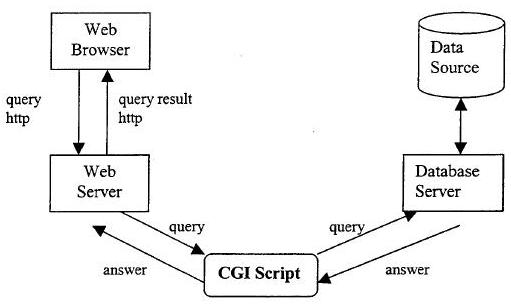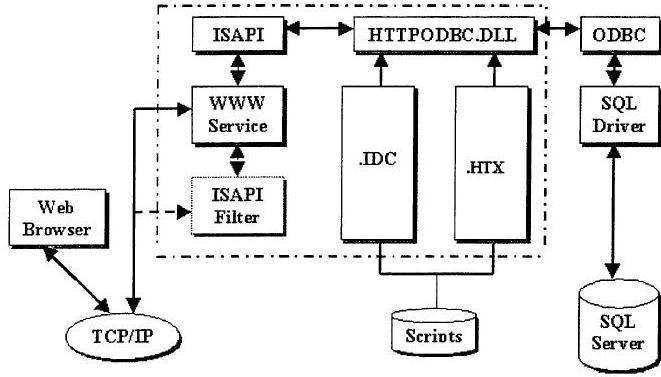SERVER EXTENSION PROGRAMS
By transforming among the database server and the web server we can see the benefits of principles in the last two tiers. And these principle’s benefits are also seen in the middle tier by using a server extension program. This explanation is one of the most essential one. For their regular boundary the interchangeability is maintained by the server extensions. With out any difficulties the database servers and web servers can be improved or replaced.
CGI for Server Extension Program
For interfacing the outside requests through the web servers, normally we are using the Common Gateway Interface. On the server the program or a script which is operated by a web server is permitted by a method known as Common Gateway Interface then for the web server the output is propelled. Either CGI is a programming language or a script is essentially recognized. To work together with the web server the database server is prepared. In Perl, C, and Tcl languages the CGI scripts are written, as a middleware it is provided.
In real-time we implement the CGI’s outside application and output information is energetically produced. The HTML documents are proceeding, when from the web clients there is a development in HTTP requests. The CGI process must be happening by the Web server for every client request; this is one of the main drawbacks. With the DBMS every CGI process create an original connection, till the outcomes are distributed the web server have to be remained.
Database access on the Web using CGI scripts
ISAPI &IDC FOR SERVER EXTENSION PROGRAM
For the internet servers instead of using the common gateway interfaces we are using the ISAPI (Internet Server Application Programming Interface) server extension. Because of these HTTP server ISA’s operate in the same address space but different like CGI applications. Across the process boundaries the time intense communications could not be carried out, and the design of an extra processes are also not required these ISA’s have less transparency than CGI applications. When an extra process requires the memory both the additional and clean DLL’s may be taken down.
The Internet Server Application Programming Interface is an Internet Database Connector. For the Open Database Connectivity the databases are sustaining, which are allowed by the IDC connected with Web pages. In the Internet server we will see the IDC file which is constructed by the Web page developers. The information when we are login, SQL query to get back the data and the source name of ODBC are identified by the IDC file where as the IDC file is a text file. To get back the data from the ODBC compliant database the model is in HTML formatting template which is created by an HTX file. These HTX file is also formed by the Web page developers. This HTX file is referenced by the IDC file.
Some of the following steps are taking place when we apply for the IDC file.
1. From the IDC file to the IDC dynamic library the Web server exceeds, when the IDC file is demanding which is accepted by the web server.
2. The IDC file is understand by the IDC DLL. For the ODBC administrator program the data source and SQL statements are transitory.
3. For the database the SQL statement is exceeding, this SQL statement is suitable for the ODBC driver when it is passed by the ODBC administrator program.
4. Any row is proceeding to the IDC DLL when the query is run by the database.
5. With this HTX file the rows come again when we combine the IDC DLL, an ordinary HTML file is generated.
6. During the Internet or Intranet connection the HTML file is get back passed by the Web server to the browser.
Internet Information Server
IDC to Access the Internet Information Server Log File, Stored in the SQL
Server Database
REMOTE METHOD INVOCATION (RMI) EXTENSION PROGRAM
The java to java applications are constructed and spread by the programmer allowed by Remote Method Invocation. From an additional Java Virtual Machine or from the dissimilar hosts remote java objects are called. For an additional remote object the server can act as a client when the remote object is described by a client in a server.
WEB BASE FOR SERVER EXTENSION PROGRAM
With a web server the web base is closely included even it relies on special tags and SQL. For Document Object Model and dynamic HTML it is normally supported by the Web base. Even there is no involvement of server the dynamic HTML can dynamically change the ActiveX objects, HTML tags, java applets, tables, text and style sheets. In any browser without any involvement of human the database can be created by web base and structured to update, add, search and view records. To use this add-on special viewers or plug-ins are not necessary.
From customer order status to complex catalog ordering applications and availability, product pricing, real estate listings the solutions are starting from single access presented by web base. The one who is browsing the website can see anything in the database made by the users or by using the password protection only specific member can see. To the reports we are adding the hypertext links when the users make powerful isolated existing database.


